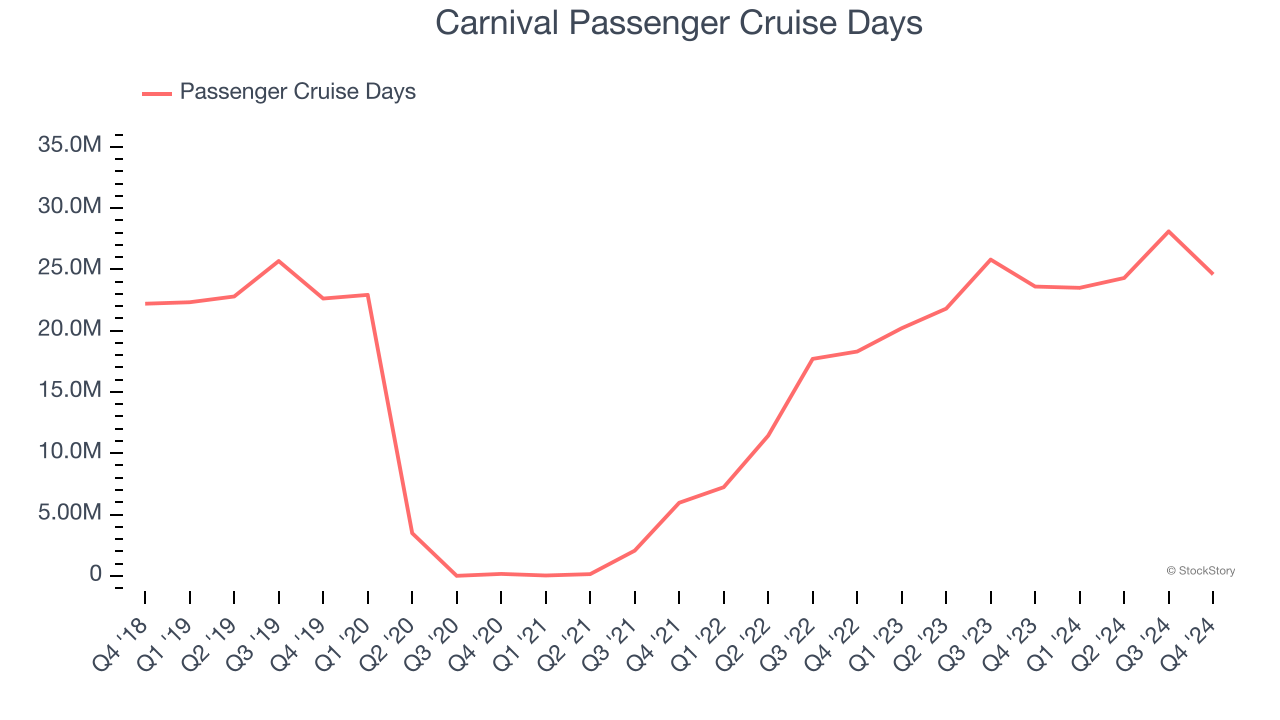Financial News
Carnival (NYSE:CCL) Reports Q4 In Line With Expectations, Stock Soars

Cruise ship company Carnival (NYSE:CCL) met Wall Street’s revenue expectations in Q4 CY2024, with sales up 10% year on year to $5.94 billion. Its non-GAAP profit of $0.14 per share was 94% above analysts’ consensus estimates.
Is now the time to buy Carnival? Find out by accessing our full research report, it’s free.
Carnival (CCL) Q4 CY2024 Highlights:
- Revenue: $5.94 billion vs analyst estimates of $5.93 billion (10% year-on-year growth, in line)
- Adjusted EPS: $0.14 vs analyst estimates of $0.07 (beat)
- Adjusted EBITDA: $1.22 billion vs analyst estimates of $1.17 billion (20.5% margin, 4.3% beat)
- EBITDA guidance for the upcoming financial year 2025 is $6.6 billion at the midpoint, in line with analyst expectations
- Operating Margin: 9.4%, up from 7.1% in the same quarter last year
- Free Cash Flow Margin: 5.4%, similar to the same quarter last year
- Passenger Cruise Days: 24.6 million, up 1 million year on year
- Market Capitalization: $32.37 billion
Company Overview
Boasting outrageous amenities like a planetarium on board its ships, Carnival (NYSE:CCL) is one of the world's largest leisure travel companies and a prominent player in the cruise industry.
Travel and Vacation Providers
Airlines, hotels, resorts, and cruise line companies often sell experiences rather than tangible products, and in the last decade-plus, consumers have slowly shifted from buying "things" (wasteful) to buying "experiences" (memorable). In addition, the internet has introduced new ways of approaching leisure and lodging such as booking homes and longer-term accommodations. Traditional airlines, hotel, resorts, and cruise line companies must innovate to stay relevant in a market rife with innovation.
Sales Growth
A company’s long-term performance is an indicator of its overall quality. While any business can experience short-term success, top-performing ones enjoy sustained growth for years. Over the last five years, Carnival grew its sales at a sluggish 3.7% compounded annual growth rate. This fell short of our benchmark for the consumer discretionary sector and is a tough starting point for our analysis.

We at StockStory place the most emphasis on long-term growth, but within consumer discretionary, a stretched historical view may miss a company riding a successful new property or trend. Carnival’s annualized revenue growth of 43.4% over the last two years is above its five-year trend, suggesting its demand recently accelerated. Note that COVID hurt Carnival’s business in 2020 and part of 2021, and it bounced back in a big way thereafter. 
We can better understand the company’s revenue dynamics by analyzing its number of passenger cruise days, which reached 24.6 million in the latest quarter. Over the last two years, Carnival’s passenger cruise days averaged 48.2% year-on-year growth. Because this number is higher than its revenue growth during the same period, we can see the company’s monetization has fallen. 
This quarter, Carnival’s year-on-year revenue growth was 10%, and its $5.94 billion of revenue was in line with Wall Street’s estimates.
Looking ahead, sell-side analysts expect revenue to grow 4.5% over the next 12 months, a deceleration versus the last two years. This projection doesn't excite us and indicates its products and services will face some demand challenges.
Software is eating the world and there is virtually no industry left that has been untouched by it. That drives increasing demand for tools helping software developers do their jobs, whether it be monitoring critical cloud infrastructure, integrating audio and video functionality, or ensuring smooth content streaming. Click here to access a free report on our 3 favorite stocks to play this generational megatrend.
Cash Is King
Free cash flow isn't a prominently featured metric in company financials and earnings releases, but we think it's telling because it accounts for all operating and capital expenses, making it tough to manipulate. Cash is king.
Carnival has shown poor cash profitability over the last two years, giving the company limited opportunities to return capital to shareholders. Its free cash flow margin averaged 4.9%, lousy for a consumer discretionary business.

Carnival’s free cash flow clocked in at $319 million in Q4, equivalent to a 5.4% margin. This cash profitability was in line with the comparable period last year and its two-year average.
Key Takeaways from Carnival’s Q4 Results
We liked how Carnival beat analysts’ EBITDA and EPS expectations this quarter. That full year EBITDA guidance was in line with expectations can be considered a solid outcome. The stock traded up 5% to $26.44 immediately after reporting.
Carnival had an encouraging quarter, but one earnings result doesn’t necessarily make the stock a buy. Let’s see if this is a good investment. What happened in the latest quarter matters, but not as much as longer-term business quality and valuation, when deciding whether to invest in this stock. We cover that in our actionable full research report which you can read here, it’s free.

Quotes delayed at least 20 minutes.
By accessing this page, you agree to the following
Privacy Policy and Terms and Conditions.



